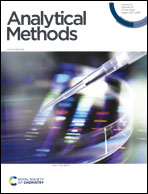Colorimetric speciation analysis of chromium using 2-thiobarbituric acid capped silver nanoparticles
Abstract
In the present work, 2-thiobarbituric acid (TBA)-capped silver nanoparticles (AgNPs) have been introduced as a novel nanoprobe in the construction of a sensitive and selective colorimetric sensor for Cr(III) and Cr(VI) ions. Cr(III) can be linked to TBA on the AgNP surface via –N or –OH groups and form a bridge between two or more AgNPs causing their aggregation. This phenomenon leads to a dramatic color change in TBA-AgNPs from yellow to pinkish red. UV-Vis spectrophotometry, FT-IR and transmission electron microscopy (TEM) were utilized for quantitative analyses, characterization of modified AgNPs and determination of the interaction mechanism of TBA-AgNPs – Cr(III). The color change depended on the concentration of Cr(III) and the ratio of UV-Vis absorption intensity at 520 nm to that at 418 nm (A520/A418) was linearly proportional to the concentration of Cr(III) from 0.012 to 3.25 mg L−1 (LOD = 8.4 µg L−1). To eliminate or reduce the interference of other cations in Cr(III) determination, EDTA was used as a masking agent at pH 6.5. Moreover, the developed method was used for the determination of Cr(VI) in the presence of ascorbic acid (AA) (as a reducing agent) in the concentration range of 0.20 to 1.40 mg L−1. The proposed probe was successfully applied for the determination of Cr(III) and Cr(VI) in cement factory wastewater.



 Please wait while we load your content...
Please wait while we load your content...